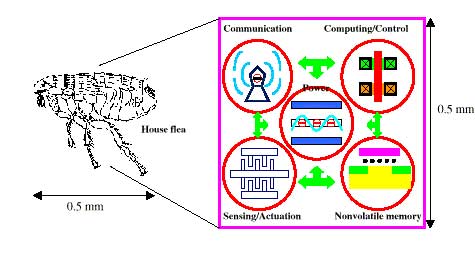Si Fleas: Technology Demonstration of Functional Modules in Submillimeter Autonomous Microsystems
School of Electrical and Computer Engineering, Cornell University,
Ithaca, NY 14853 USA
This is an abstract
for a presentation given at the
Ninth
Foresight Conference on Molecular Nanotechnology.
There will be a link from here to the full article when it is
available on the web.
Small insects, such as fleas and mites, are submillimeter autonomous microsystems with the basic but sufficient capabilities of power, sensing, actuation, communication, computing, control and reproduction. Under the less controllable (but somewhat predictable) environmental variation during the life cycles from the insects� point of view, their systems represent an optimal integration scheme. There may be intellectual and economical reasons to reinvent what nature has already perfected under environmental constraints by bio-mimicking the components or the integration strategy. However, a more intriguing question is: if we remove the constraint on reproduction by providing a controlled manufacturing process and by eliminating the self-replicating functional modules, can we achieve an autonomous microsystem that is comparable in form factor, but much better in specific functionality?
Si technology has made great strides in the past 40 years in scale, cost, complexity and yield. Although numerous arguments have been made to predict the remaining steams in present Si technology (Wong 1999), there are two categories of genuine knowledge that will be crucial in any kind of future nanotechnology: 1) the low-cost, high-yield manufacturing of nanoscale layers and deep submicron planar resolution, 2) the integration scheme in physical technology and design hierarchy. Most efforts in Si technology have focused on functional modules for computing and control applications, though recently more attempts have been made in wireless communication (Darpatech 1999) and mechanical sensing and actuation (Kovacs 1998). However, for a submillimeter autonomous microsystem whether biological or inorganic, if the reproduction module is excluded, the most critical system component is power generation, with all other functional modules of communication, sensing, actuation, computing and control operated under the available power budget. This real-power integration scheme (for both continuous and peak power) has a deep impact on the choice of module implementation in the autonomous microsystem.
Several schemes for power generation under small system size in Si technology have been proposed (Amirtharajah 1998, Darpatech 1999), but all with severe constraints to be included in a submilliter autonomous system. Our implementation strategy is to take advantage of the new technology integration of EEPROM and MEMS to create functional modules that cannot be achieved in other approaches (Kan 2000). We will demonstrate prototypes of electrostatic repulsive forces for micro-mechanical structures, static-charge antenna for near-field transmission, and vibration-based self-starting generators. Comparison with other options including biological modules will be made in view of integration capabilities, power efficiency and overall controllability.
References
- Amirtharajah R., Chandrakasan A. P. (1998): IEEE J. Solid-state Circuits, vol. 33, pages 687-695. Self-powered signal processing using vibration-based power generation.
- Darpatech (1999): http://www.darpa.mil/darpatech99/presentations.htm.
- Kan E. C., Liu Z., Kim M., Narayanan V., Shen Y. N. (2000): Eighth Foresight Conference on Molecular Nanotechnology. "Submillimeter autonomous microsystems enhanced by mobile nonvolatile static charges in nanocrystals."
- Kovacs G. T. A. (1998): Micromachined Transducers Sourcebook, McGraw-Hill.
- Wong H-S. P., Frank D. J., Solomon P. M., Wann C. H. J., Welser J. J. (1999): Proc. IEEE, vol. 87, no. 4, pages 537-570. Nanoscale CMOS.

Abstract in RTF format 70,270 bytes
*Corresponding Address:
Edwin C. Kan
School of Electrical and Computer Engineering, Cornell University
404 Phillips Hall, Ithaca, NY 14853 USA
Phone: 607-255-3998
Fax: 607-254-4565
Email: [email protected]
http://www.ece.cornell.edu/~kan
|